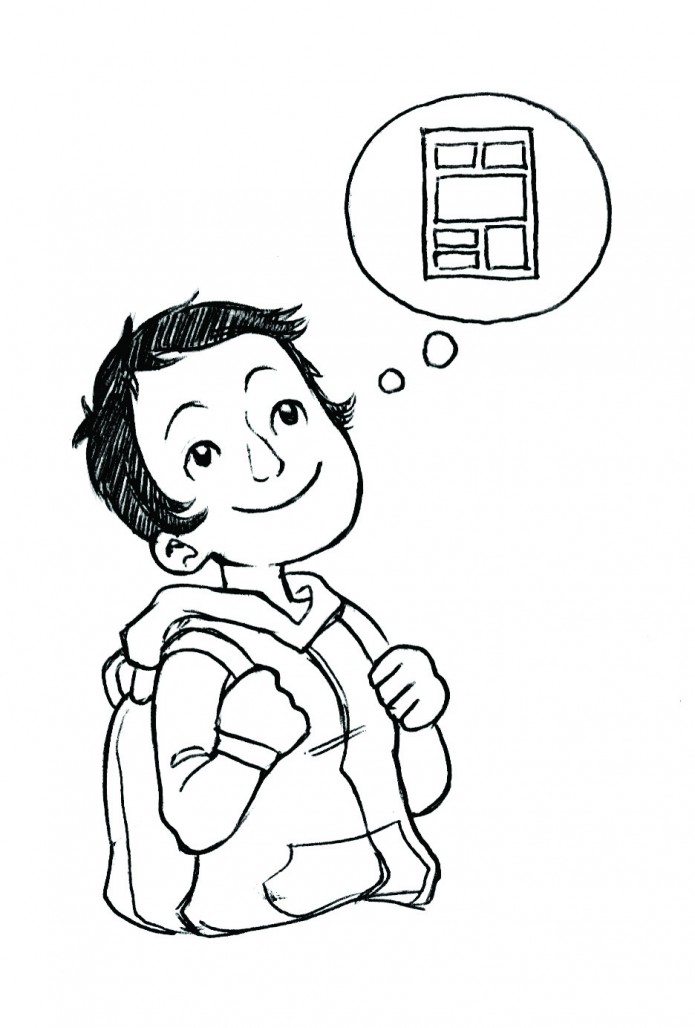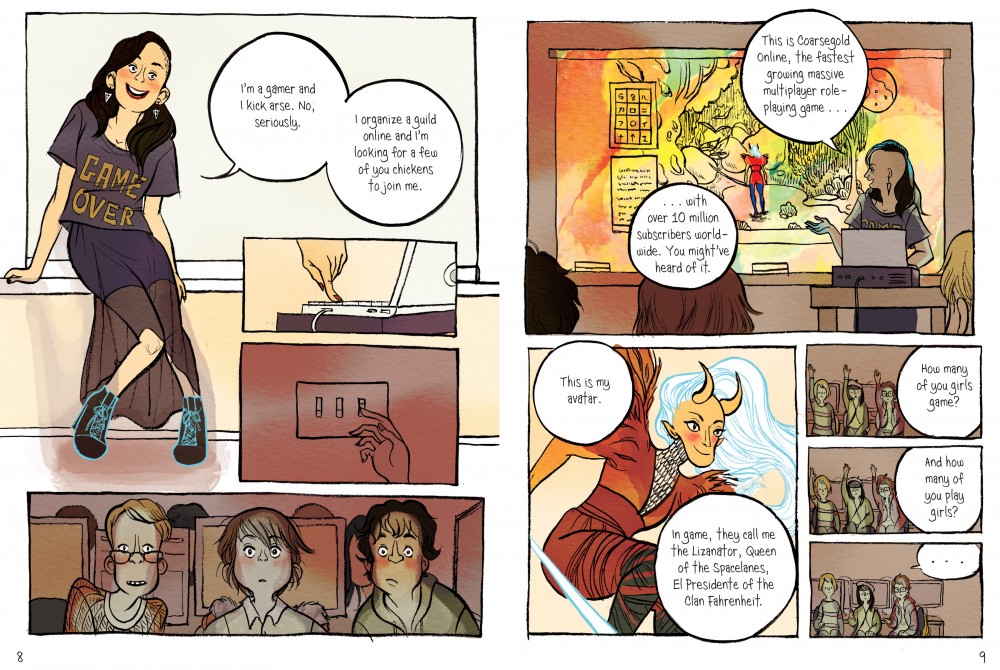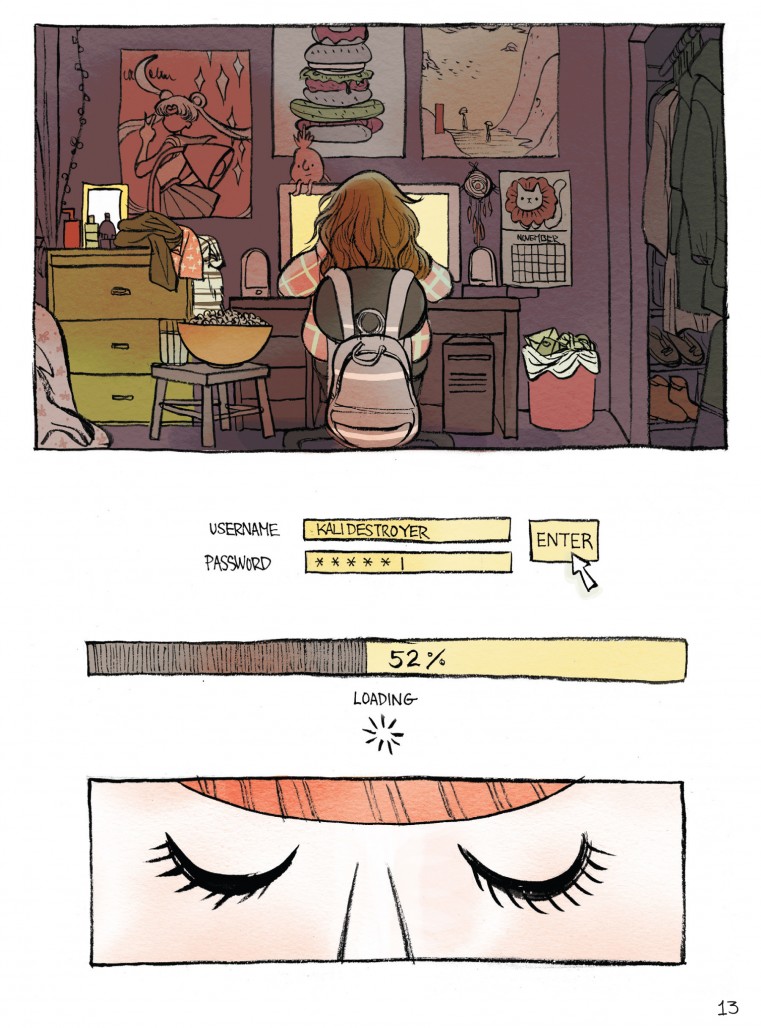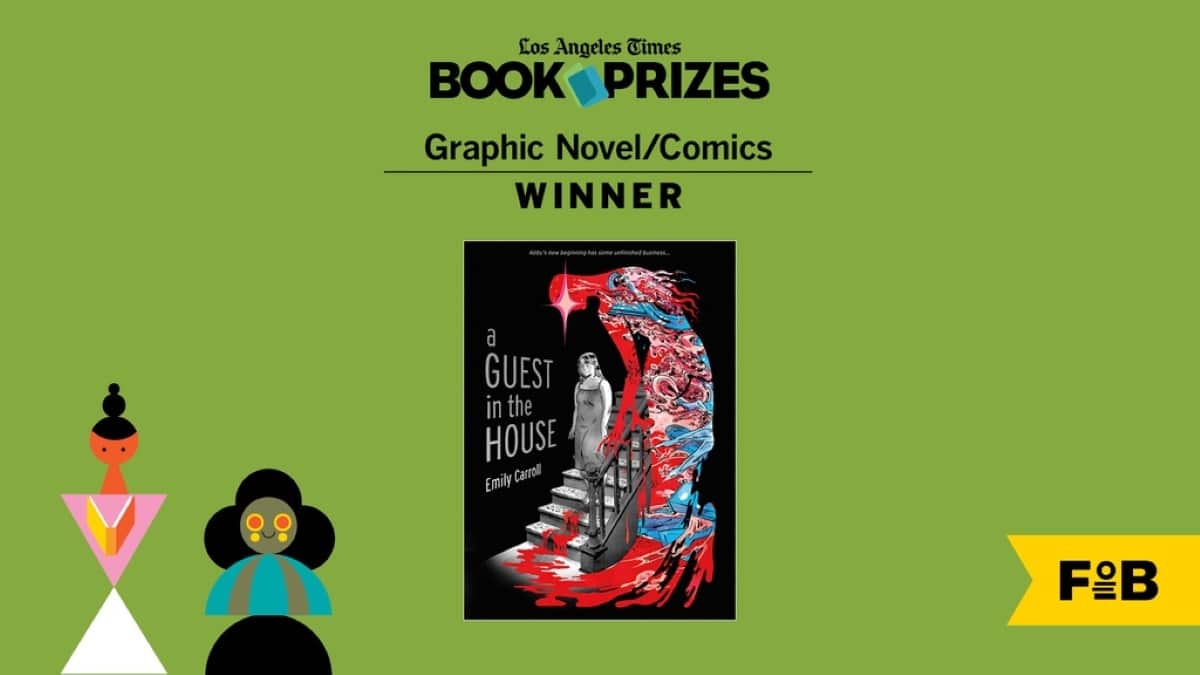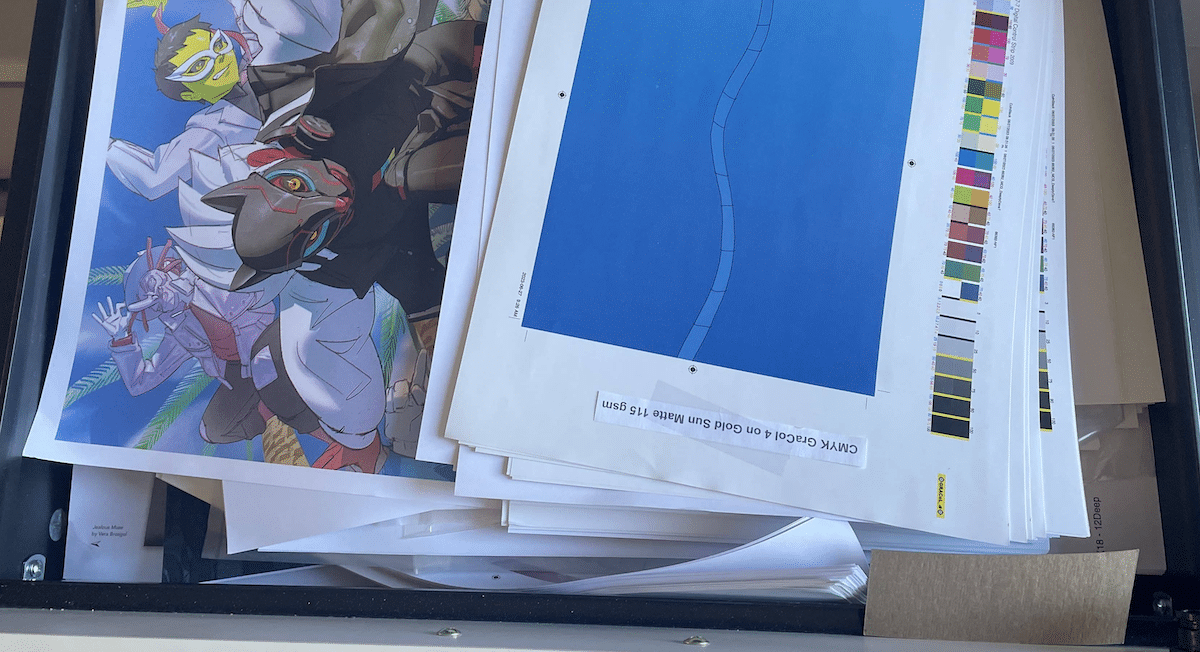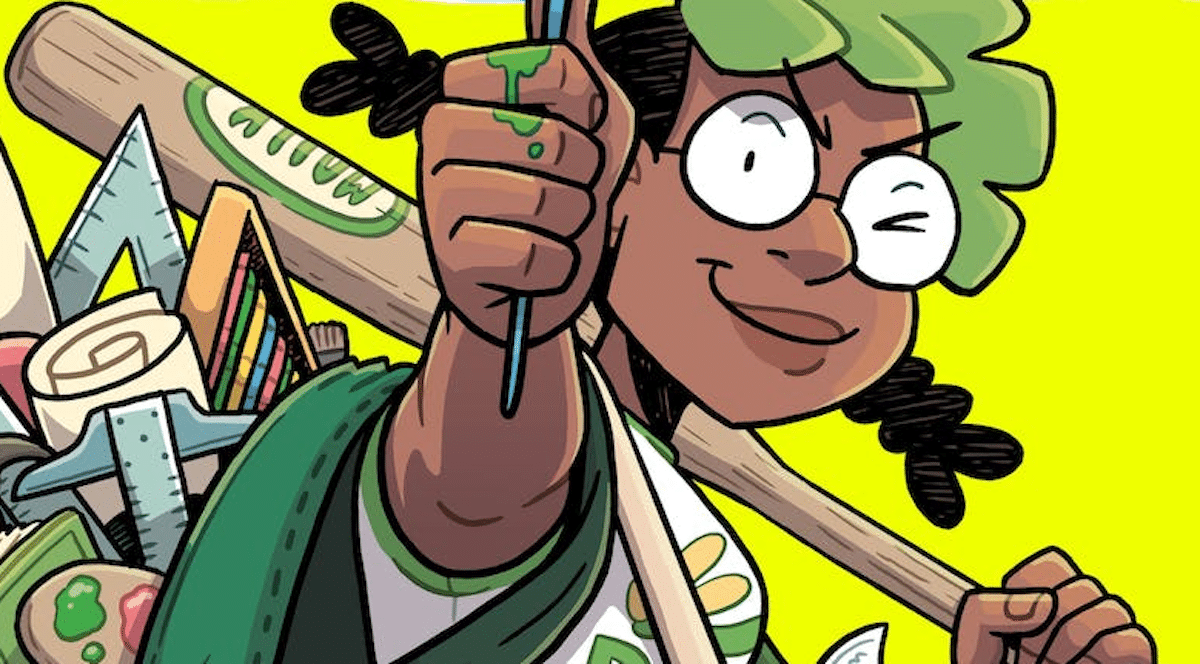 By Kyle Pinion
By Kyle Pinion
IN REAL LIFE, a graphic novel collaboration between journalist/author Cory Doctorow and comics creator Jen Wang, centers on a young gamer named Anda who becomes enraptured by an massively multiplayer online game (MMO) called “Coarsegold Online”. While logged-in, she makes new friends, including a gregarious fellow gamer named “Sarge” and a “gold-farmer” from China named Raymond. It’s the latter whose activities, which center on illegally collecting valuable objects in the game and selling them to other players from developed countries, begin to open up Anda’s perspectives on the concepts of right and wrong, and the power of action towards civil rights.
The book was a true eye-opener for me, as I’m not a gamer by any stretch of the imagination beyond the occasional dalliance on my console system at home. I was delighted when I received an opportunity to chat with Jen Wang about the origins of this project, its underlying themes, and how much of her own gaming experience played into the development of the narrative.
How did IN REAL LIFE (IRL) find its genesis? Did you know Cory Doctorow prior to working on this project?
Prior to IN REAL LIFE I was familiar with Cory Doctorow as a blogger and activist but I hadn’t read his fiction. ANDA’s GAME, the short story IRL is based on was actually the first piece I read. My publisher First Second sent me a link to the short and asked if I’d be interested. After reading that, it was hard to say no!
What is it about the subject matter that drew you in initially?
I like that it takes gaming, which many people see as frivolous entertainment, and gives it a real life context. The internet is inherently a social platform and it makes sense that it reflects our darker tendencies, such as exploiting people. I also like that it touches on the tension between China and the West. There’s just so much interesting material to explore and at the end of the day it’s still a simple story about two teenage gamers from different countries who become friends.
Your previous work, KOKO BE GOOD, also published through First Second, was solely written and illustrated by yourself. Do you find that there are inherent advantages in the collaborative process, and is there a method you prefer over the other?
It’s definitely a lot easier to illustrate your own work, that’s for sure. The collaborative process is more challenging, but you also get a second point a view and a direction to work towards. Sometimes in your personal work it takes a lot of soul searching to figure out what you’re trying to say but a collaborate project allows you to bounce off other people’s ideas and that’s really refreshing.
On the day to day work on the graphic novel, what was the working relationship between Cory and yourself? Were you in constant contact?
During the scripting phase of the book we were sending a lot of emails. I would write a draft, send it to Cory, and he would send some notes and bounce some ideas back. We went through maybe 8 or so drafts so it took a little while to nail down the final. I was pretty much left alone at the drawing stage, however.
How much of a specific vision did Cory have in the initial “Anda’s Game” script, and how much input did you have on character design before the development of IRL? Do you feel like Anda specifically has your “stamp” on her?
I had pretty much free reign as far as design went, so that part was fairly easy. When First Second approached me to do the project they wanted me to feel comfortable writing my own take, so mostly it was me pitching ideas to Cory and him giving me notes. I do feel like I have my stamp on Anda but then again I don’t know how it wouldn’t have happened naturally. She’s a nerdy teenage shut in and having been one myself I can relate to that a lot.
The gaming details throughout are very specific, do you have a significant gaming/MMO background as a user? If not, is that an area where Cory contributed significantly?
I don’t really have a background in MMOs but I played World of Warcraft for a couple weeks prior to starting the project. That plus a combination of sandbox games I’ve played were the inspiration for Coarsegold online. I mostly tried to create a game that felt familiar and yet tailored it to things I like in games. I’m very much into customization and resource management so it was fun to add things like to the book.
How do you sense that communication has changed for Generation Y and The Millennials? Do you find that you side more with Anda or her mother in what technology brings to social interaction?
I’m definitely on the Millennials side. I can’t imagine what my life would be like now if I didn’t have access to the internet as a teenager. I met so many other young artists online and they really motivated me to create and challenge myself. Without it, I would’ve had to seek these people out in college in person and I would’ve been a lot more lonely and isolated. There are risks to putting yourself online but there are risks to be alive in the real world as well. The best you can do is exercise caution and be smart about your privacy in the same way you would anywhere.
Is there anything from your own experience pulled into Anda’s story, at least from a characterization standpoint? Do you see Anda as a role model? Was that the intention all along?
I was a lot like Anda in high school. I was a teenage hermit who spent a lot of time connecting to peers online within my community of choice. Like Anda, I found my identity online because I was able to meet other people like myself. I see Anda less as a traditional role model and more as someone readers could relate to. Like Anda, most young people now are discovering the world through the internet and it can be a difficult place to navigate.
What drove the design of the world of Coarsegold? Any specific influences?
World of Warcraft is the main one, but I also looked at the Final Fantasy games, Skyrim, and more open world games like Animal Crossing, The Sims and Second Life.
What was the thought process on the color-design that differentiates Coarsegold from “the real world”?
I definitely wanted Coarsegold to be more bright and colorful by contrast as a reflection of Anda’s feelings toward both realities. I used different filters and colored textures so that real life was a little more tan and monochromatic while Coarsegold looked lively and exciting.
When Anda somewhat bridges the gap between the two by changing her hair color to match her avatar, what kind of sea-change does that indicate for her personally?
At that point in the story Anda has finally found purpose and confidence in her role as a Fahrenheit. Not only has she befriended Raymond and discovered this world of goldfarming, but she’s taken on the task of helping him. It’s a decision she’s been able to make for herself separate from what her peers have led her to believe, and changing her hair color is a symbol of this newfound confidence.
IN REAL LIFE defies expectations a bit in that it shifts a bit touching briefly on females in gaming (with the very succinct hand-raising scene in the classroom and some of the concerns of “Sarge”) and then moves into an area centering on economics and specifically civil rights. Do you sense a strong correlation between the two themes?
Oh, for sure. As in real life, the conflict within Coarsegold comes from who is considered an “other.” As a young girl in gaming, Anda is a minority, yet she’s in a position of power compared to Raymond who is not only a foreigner who doesn’t speak English, but also a goldfarmer. They’re able to connect as outsiders of this gaming establishment and both are fighting for the right to be themselves and be seen as equals.
I have to admit that the term “gold farming” is fairly new to me (as a non-gamer), and IRL paints a very morally grey picture around that activity, what do you feel as though readers should take from the book’s portrayal of that subject?
Gold farming was new to me too until I started researching for this book. There is a lot of grey area and it’s still evolving. What I do hope the readers takes away from IRL is the ability to keep an open mind about the people on the other side of the tracks and be empathetic to their struggles. On the surface the gold farming community appears to be taking advantage of game-makers and the “purity” of the game. On the other hand the gold farmers themselves are actually big fans who can only participate by being taken advantage of.
What inspired the creation of Raymond? Both in the look of his avatar and the character’s plight in China?
I wanted the goldfarmers to look small and vulnerable compared to everyone else. They haven’t been able to level up their characters and they’re not customized so Raymond doesn’t look any different from his peers. I also wanted them to not look human so as to “otherize” the goldfarmers in the eyes of Anda and Lucy at the beginning of the story. For Raymond’s human backstory I took a lot of inspiration from a book I read called FACTORY GIRLS: FROM VILLAGE TO CITY IN A CHANGING CHINA by Leslie T. Chang. It paints these very compassionate portraits of young female migrant workers and the everyday victories and struggles they face. Raymond comes from a very disadvantaged background but he’s also clever and ambitious enough to get what he wants (to play Coarsegold) with the means that he has.
Do you feel a sense of responsibility to educate as a creator publishing a book within the Young Adult literary genre? Does that affect the kinds of stories you hope to tell?
I don’t make it a point to be an educator, but I hope my stories reflect the world I’d like to see and the problems I’d like us to overcome.
If there was one-key take away or message from IN REAL LIFE that should highlighted, what would that be?
Be compassionate to others and be aware of how your role in the community may be inadvertently hurting others less privileged than you.
What’s next on the horizon for you post the release of IRL next month? Any new projects that you can share?
I have a couple new projects I can’t really talk about yet, but I’m excited to share I’m co-organizing a new comics festival in Los Angeles called Comics Arts LA. It’s a one day event that will take place on December 6th. We’ve got really great exhibitors lined up so it’s going to be fun. If any readers out there are in Southern California that weekend, I encourage you to come check it out! http://comicartsla.com
IN REAL LIFE will be available in a bookstore near you on October 14th through First Second


